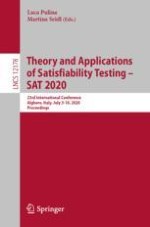This book constitutes the proceedings of the 23rd International Conference on Theory and Applications of Satisfiability Testing, SAT 2020, which was planned to take place in Alghero, Italy, during July 5-9, 2020. Due to the coronavirus COVID-19 pandemic, the conference was held virtually.
The 25 full, 9 short, and 2 tool papers presented in this volume were carefully reviewed and selected from 69 submissions. They deal with SAT interpreted in a broad sense, including theoretical advances (such as exact algorithms, proof complexity, and other complexity issues), practical search algorithms, knowledge compilation, implementation-level details of SAT solvers and SAT-based systems, problem encodings and reformulations, applications (including both novel application domains and improvements to existing approaches), as well as case studies and reports on findings based on rigorous experimentation.
